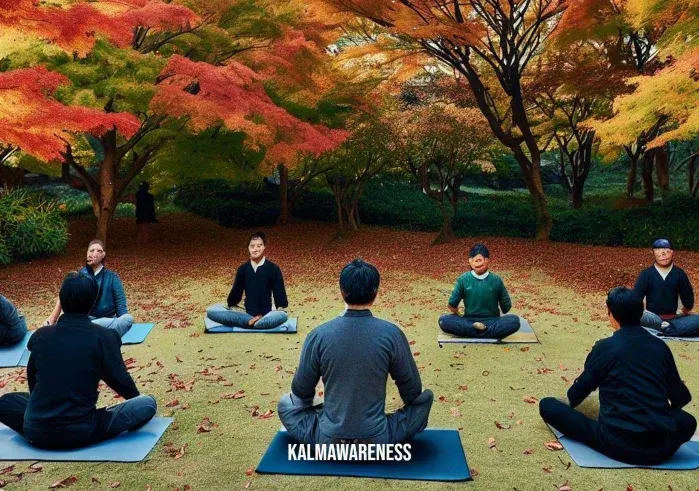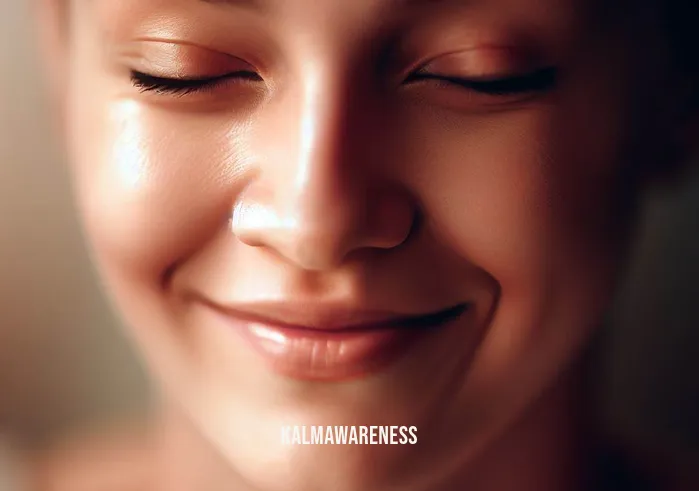The Breath of Zen: A Path to Inner Calm and Mindfulness
Life has a way of piling upon us, leaving us gasping for air under the weight of endless tasks, responsibilities, and anxieties. But there is a way out, a method that can lead you to a place of inner calm, peace, and enhanced well-being. Welcome to the journey of the ‘Breath of Zen.’ This soothing technique, rooted in centuries-old practices, holds the key to rejuvenating your body, mind, and spirit.
The Essence of Zen
The ‘Breath of Zen’ is not merely a physical act but a pathway to mindfulness. Embracing this form of breath work means entering a state of deep, conscious awareness, where every inhalation and exhalation holds a purpose. Let’s explore this profound concept and how it can transform your life.
What is Zen?
Zen is not just a term, it is an experience. Originating from Buddhist teachings, it signifies a state of tranquil simplicity, free from the whirlwind of thought. The heart of Zen lies in understanding and accepting the moment as it is, without judgment or resistance. This meditative practice invites you to truly breathe it in.
Breath: The Pathway to Zen
The beauty of the ‘Breath of Zen’ lies in its simplicity. It is not about mastering complex poses or memorizing mantras. Instead, it rests on the most basic and vital action of your life – breathing. With every breath, you are invited to anchor your awareness in the present moment, and experience the depth and richness of now.
Through Zen, we learn that there is no need to rush or resist, only to breathe and be. This might seem like a simple practice, but its impact on our mind and body is profound. It is akin to the calming effect experienced during a gong meditation in Kundalini Yoga, where the vibrations guide you towards a state of deep relaxation.
The Breath of Zen and Mindfulness
Incorporating the ‘Breath of Zen’ into your routine can help you cultivate mindfulness, a state of heightened awareness and acceptance of your thoughts, feelings, and sensations. Mindfulness is a potent tool for personal growth and well-being, allowing you to navigate the storms of life with equanimity.
Breath as an Anchor
In the practice of mindfulness, your breath serves as an anchor, grounding you amidst the fluctuations of daily life. It brings your attention back to the present, detaching you from past regrets and future anxieties. This way, you can find peace in the middle of chaos, much like remaining calm during the final pose in a yoga session, also known as Savasana.
The Power of Now
With the ‘Breath of Zen,’ every moment becomes a miracle. You learn to appreciate the present for what it is – a priceless gift. As you breathe, you start to feel an intimate connection with life, realizing that the secret to happiness lies not in pursuing future goals, but in cherishing the now.
A moment of mindfulness might not seem like much, but it’s a step towards a deeper understanding of yourself and the universe around you. Just as the power of mindfulness magazine explains, these moments can accumulate to bring significant change in your life and overall well-being.
Join us in the next part of this article, where we will delve deeper into the practice of the ‘Breath of Zen,’ its impact on your physical health, and its role in stress management. We will also explore how you can incorporate this breathwork into your daily routine for optimum results. See you in the next chapter!

The Practice and Benefits of the Breath of Zen
With the hustle and bustle of our modern lives, it is no surprise that more and more people are turning to mindfulness practices like the Breath of Zen to find balance and peace. This ancient art is not just about controlling your breathing but understanding the deep connection between your mind, body, and spirit.
The Breath of Zen Technique
This calming breathwork technique is quite straightforward, making it easy to incorporate into your daily routine. Here’s how you can begin your journey with the Breath of Zen:
- Find a comfortable spot: First, find a quiet and comfortable space where you can sit undisturbed. You can use a chair or cushion, or even sit on the ground.
- Adopt a relaxed posture: Make sure your body is relaxed and your spine is upright. You can think of it as achieving a balance between being alert and relaxed, similar to settling into a fetal pose in yoga.
- Close your eyes: Gently close your eyes to minimize external distractions and help focus your attention inward.
- Breathe naturally: Notice the sensation of your breath as it flows in and out. There is no need to manipulate it in any way. Just let it be.
- Stay present: As you breathe, let your attention stay with the sensation of your breath. If your mind wanders, gently bring it back to your breath without judgment.
Remember, the key to the Breath of Zen is in the simplicity of being with your breath, fully present, moment by moment.
Physical Benefits of the Breath of Zen
Engaging in the Breath of Zen practice offers several benefits to your physical health. It works at a physiological level, bringing about changes that enhance your well-being:
- Stress Reduction: The Breath of Zen helps in managing stress by calming your mind and relaxing your body. It activates your parasympathetic nervous system, which triggers the body’s ‘rest and digest’ response. This is similar to the effects of biological stress reduction methods.
- Improved Respiratory Health: Regular practice of mindful breathing enhances lung function and capacity. It also promotes better oxygen circulation in the body.
- Lower Blood Pressure: The deep relaxation triggered by the Breath of Zen helps lower blood pressure and maintain heart health.
- Enhanced Digestion: By promoting the ‘rest and digest’ response, the Breath of Zen supports better digestion and nutrient absorption.
Psychological Benefits of the Breath of Zen
The practice of the Breath of Zen also offers profound psychological benefits. Regular practice can help you to:
- Calm Anxiety: The focus on breath helps to break the cycle of anxious thoughts. It is a powerful tool, much like a guided meditation for anxiety and overthinking.
- Promote Emotional Stability: By fostering mindfulness, the Breath of Zen encourages you to acknowledge and accept your emotions without being overwhelmed by them.
- Boost Focus and Concentration: The practice trains you to focus on a single point (breath), improving your concentration skills.
- Enhance Self-awareness: The Breath of Zen makes you more aware of your mind-body connections, encouraging introspection and self-understanding.
| Benefits of the Breath of Zen | Description |
|---|---|
| Stress Reduction | Activates the body’s ‘rest and digest’ response, calming the mind and body. |
| Improved Respiratory Health | Enhances lung function and oxygen circulation. |
| Lower Blood Pressure | Helps maintain heart health by reducing blood pressure. |
| Enhanced Digestion | Supports digestion and nutrient absorption. |
| Calm Anxiety | Helps break the cycle of anxious thoughts. |
| Promote Emotional Stability | Encourages acceptance of emotions without being overwhelmed. |
| Boost Focus and Concentration | Trains the mind to focus on a single point. |
| Enhance Self-awareness | Promotes awareness of mind-body connections. |
In the next chapter, we will delve deeper into how to enhance your Breath of Zen practice by creating a serene environment and employing mindfulness tools. We’ll provide insights into making the most of your practice and maintaining your calm and focus. Stay tuned!

Enhancing Your Breath of Zen Practice: Tools, Tips, and Wisdom
Continuing your journey into the calming and clarifying practice of the Breath of Zen, it’s crucial to consider the importance of your environment and the power of helpful tools and wisdom that can enhance your mindfulness experience. This chapter is dedicated to sharing practical guidance on creating an ideal space for practice, integrating helpful tools, and inspiring you with profound quotes from renowned mindfulness gurus.
Creating a Serene Environment for Practice
The environment in which you practice your Breath of Zen can play a significant role in determining the quality of your experience. Here are some essential elements to consider:
- Quiet and Clean Space: Find a space that is free from noise and clutter. A clean, open space can help clear your mind, allowing you to focus better on your breath.
- Comfortable Seating: Whether you prefer a chair, a cushion, or the bare floor, ensure that your seating arrangement is comfortable and supports an upright posture.
- Pleasant Lighting: Soft and warm lighting can help create a calming atmosphere, enhancing your practice. If possible, opt for natural light.
- Nature: Incorporating elements of nature, such as plants, can elevate the tranquility of your space. As Thich Nhat Hanh, the Zen master, once said, “Breath is the bridge which connects life to consciousness, which unites your body to your thoughts.” Similarly, incorporating nature connects your practice to the rhythm of life, enhancing your conscious vitality.
Mindfulness Tools for Enhanced Practice
While the Breath of Zen is essentially simple, integrating mindfulness tools can help enhance your practice:
- Meditation Apps: Apps like Calm and Headspace offer guided meditations and mindfulness exercises, including breathwork. They can serve as your personal guide into the realm of Zen.
- Aromatherapy: The use of calming scents like lavender or chamomile can help enhance your sense of calm during practice. This head cool article explains it more.
- Bells and Chimes: The gentle, resonating sound of bells or chimes can serve as a focal point during your practice, helping you stay grounded in the present moment.
Quotes to Inspire Your Practice
Here are some inspiring quotes from prominent mindfulness practitioners that will help illuminate your path in the Breath of Zen journey:
- “Feelings come and go like clouds in a windy sky. Conscious breathing is my anchor.” – Thich Nhat Hanh
- “In the process of letting go, you will lose many things from the past, but you will find yourself.” – Deepak Chopra
- “Breathing in, I calm my body. Breathing out, I smile.” – Thich Nhat Hanh
- “The present moment is filled with joy and happiness. If you are attentive, you will see it.” – Thich Nhat Hanh
- “When the mind is calm, how quickly, how smoothly, how beautifully you will perceive everything.” – Paramahansa Yogananda
- “Simply let experience take place very freely, so that your open heart is suffused with the tenderness of true compassion.” – Tsoknyi Rinpoche
In the next chapter, we will explore how the Breath of Zen influences your daily life, transforming your perspective and interactions with the world around you. We will also consider how you can integrate this practice into your routine to maintain your calm and focus throughout the day. Stay with us as we deepen our understanding of the incredible power of the Breath of Zen.

Implementing Breath of Zen into Your Daily Life: Transcend and Transform
Integrating the practice of the Breath of Zen into your daily routine doesn’t just offer moments of tranquility, but it’s also an opportunity to transform your perspective, your responses, and your interaction with the world. This chapter will guide you on how to seamlessly incorporate this practice into your daily life, outlining potential challenges and solutions, and sprinkling in a touch of hope and confidence through inspiring quotes.
The Transformative Power of Breath of Zen
The Breath of Zen is more than a relaxation technique. It’s a transformative practice that can shift your way of being, moving you from a state of constant reaction to one of mindful response. You may start to observe the following changes in your daily life:
- Increased Patience: As you develop the ability to remain in the present moment, you cultivate patience, which can significantly improve your relationships and overall quality of life.
- Improved Focus: The practice of focusing on your breath helps sharpen your concentration, improving your performance at work and other daily tasks.
- Greater Emotional Balance: The mindful observation of your breath can help you develop emotional resilience, allowing you to remain centered amid life’s ups and downs.
Integrating Breath of Zen into Your Daily Routine
It’s not about carving out large chunks of time for meditation, but about integrating mindfulness into your daily activities. Here are some suggestions:
- Morning Ritual: Start your day by focusing on your breath for a few minutes. This simple ritual can set a calm and mindful tone for the rest of your day.
- Mindful Tasks: Transform mundane tasks like washing dishes, cleaning, or walking into mindfulness exercises by focusing on your breath. These tasks can be opportunities for practicing the breath wave.
- Mindful Breaks: Instead of reaching for your phone during breaks, practice a few minutes of mindful breathing to recharge and refresh your mind.
Overcoming Challenges in Practice
While establishing a Breath of Zen practice can be beneficial, it’s not without its challenges. Here’s a table that identifies some common obstacles and provides solutions:
| Challenges in Practice | Solutions |
|---|---|
| Difficulty in Concentration | Begin with shorter periods of practice and gradually increase the duration as your concentration improves. |
| Physical Discomfort | Ensure a comfortable posture and seating arrangement. Yoga can be an excellent complement to meditation. Learn more from our yoga for flexible mind and body article. |
| Restlessness | Practice at a time when you’re not in a hurry. Early morning or before bed can be ideal times. |
Inspiring Quotes for Confidence and Hope
- “In the middle of difficulty lies opportunity.” – Albert Einstein
- “You are never too old to set another goal or to dream a new dream.” – C. S. Lewis
- “Believe you can and you’re halfway there.” – Theodore Roosevelt
- “The only limit to our realization of tomorrow will be our doubts of today.” – Franklin D. Roosevelt
- “Your calm mind is the ultimate weapon against your challenges. So relax.” – Bryant McGill
- “Everything you’ve ever wanted is on the other side of fear.” – George Addair
In the next chapter, we’ll delve deeper into how Breath of Zen relates to various forms of meditation and mindfulness practices, and we’ll learn about the scientific backing that supports the benefits of such practices. Stay tuned as we continue to explore the fascinating world of the Breath of Zen.

The Multifaceted Universe of Zen Breathing: Exploring Connections and Scientific Backing
As we continue to navigate the sea of mindfulness, we encounter the broader world where the “Breath of Zen” seamlessly integrates. In this chapter, we’ll uncover the links between this practice and various forms of meditation. Additionally, we’ll provide insights into the science that lends credibility to the transformative power of the Breath of Zen.
Breath of Zen and Other Forms of Meditation
The Breath of Zen shares the same meditation stage with many practices. Each, with its distinct characteristics, ultimately seeks the same outcome – inner peace and increased awareness. Let’s draw some parallels:
Mindfulness Meditation and Breath of Zen
Mindfulness meditation revolves around the principle of being fully present in the moment. The Breath of Zen is a practical manifestation of this principle. By focusing on the breath, practitioners bring themselves into the present moment, away from past regrets or future anxieties. Our guide to anxiety attack meditation provides insights into how mindfulness can aid in anxiety management.
Gong Meditation and Breath of Zen
Gong meditation, also known as gong meditation kundalini yoga, uses sound to bring about healing and mindfulness. The Breath of Zen aligns with this practice as it introduces a rhythmic pattern – the sound and sensation of the breath – that brings about similar outcomes.
Mantra Meditation and Breath of Zen
Mantra meditation uses repetitive sounds or phrases to clear the mind, similar to the way the Breath of Zen uses the rhythm of the breath. Buddhist healing practices often include the use of Buddhist healing mantras for peace and mindfulness.
Scientific Backing of Breath of Zen Practice
The power of Breath of Zen is not just anecdotal but has also been the subject of numerous scientific studies. Researchers have discovered that regular meditation can lead to tangible physical and mental benefits. Here are some of the key findings:
- Brain Plasticity: Studies show that regular meditation can change the structure and function of the brain through neuroplasticity. This can lead to improved cognitive functions and emotional regulation.
- Stress and Anxiety: Breathing exercises are shown to regulate the autonomic nervous system, reducing stress hormones in the body. This complements our understanding of biological stress.
- Emotional Health: Consistent practice of mindfulness meditation can help manage mood disorders and improve overall emotional health. This ties in with the wisdom shared in our Ted Talk joy article.
As the famous scientist Carl Sagan once said, “Science is not only compatible with spirituality; it is a profound source of spirituality.” It’s empowering to know that the centuries-old wisdom of Breath of Zen aligns with contemporary scientific findings.
In the final chapter, we’ll embark on a fascinating exploration of how the Breath of Zen permeates various aspects of life beyond the meditation cushion. We’ll also share valuable resources to aid you on your journey. Continue reading to unlock the full potential of the Breath of Zen.

The Breath of Zen in Everyday Life: Incorporating Mindfulness in Our Routine
As we reach the final chapter of our journey into the “Breath of Zen”, it’s time to shed light on how this practice can be seamlessly integrated into our daily lives. Incorporating Zen breathing in your everyday routine doesn’t merely lead to isolated moments of calm; it can infuse your entire day with a sense of mindfulness and peace.
The Zen Way of Living
To fully embrace the breath of Zen is to adopt a lifestyle that promotes harmony between the body, mind, and spirit. The breath, in this regard, is our consistent anchor to the present moment, leading us to a more attentive, mindful state throughout the day.
Cultivating Conscious Vitality
Vitality is not just about physical energy but also about mental resilience. Regular practice of Zen breathing can help in conscious vitality, a state of being where we are not just surviving, but thriving in all aspects of our lives.
Finding Calm Amidst Chaos
In the face of life’s many stressors, the breath of Zen serves as a refuge. Whether it’s dealing with biological stress or finding calm amidst chaos, the practice of Zen breathing grounds us, fostering equanimity and poise.
Nurturing A Flexible Mind and Body
Incorporating Zen breathing in practices like yoga enhances our physical flexibility while nurturing a flexible mind. The “Breath of Zen” merges well with yoga for flexible mind and body, leading to a harmonious blend of physical and mental agility.
Breath of Zen Beyond Meditation
Zen breathing is not just confined to the time spent on the meditation mat. It can be a constant companion, guiding us through life’s various scenarios.
At Work
We often find ourselves overwhelmed with responsibilities and deadlines at work. Adopting Zen breathing during these high-stress times can act as a mini-refresh button, helping us stay focused and maintain composure.
In Relationships
Engaging in mindful communication, with the breath as our anchor, can significantly improve our interpersonal relationships. Being present in the moment allows us to listen and express ourselves more effectively.
While Walking
Our daily walks can turn into a moving meditation with the breath of Zen. Each step taken with mindfulness can become an exercise in being present and aware. Our guide on Keep walking, Happy step offers great insights on this.
As we conclude, it’s important to remember that the journey of Zen breathing is not a destination but a path. As Zen Master Thich Nhat Hanh puts it, “There is no way to happiness; happiness is the way”. The “Breath of Zen” is that way, infusing our lives with conscious presence and joy.
Thank you for joining us on this journey of exploration. Continue your exploration with The Power of Mindfulness magazine for more articles on mindfulness, meditation, and well-being. And remember, with each breath you take, you’re one step closer to your own Zen-filled journey.




